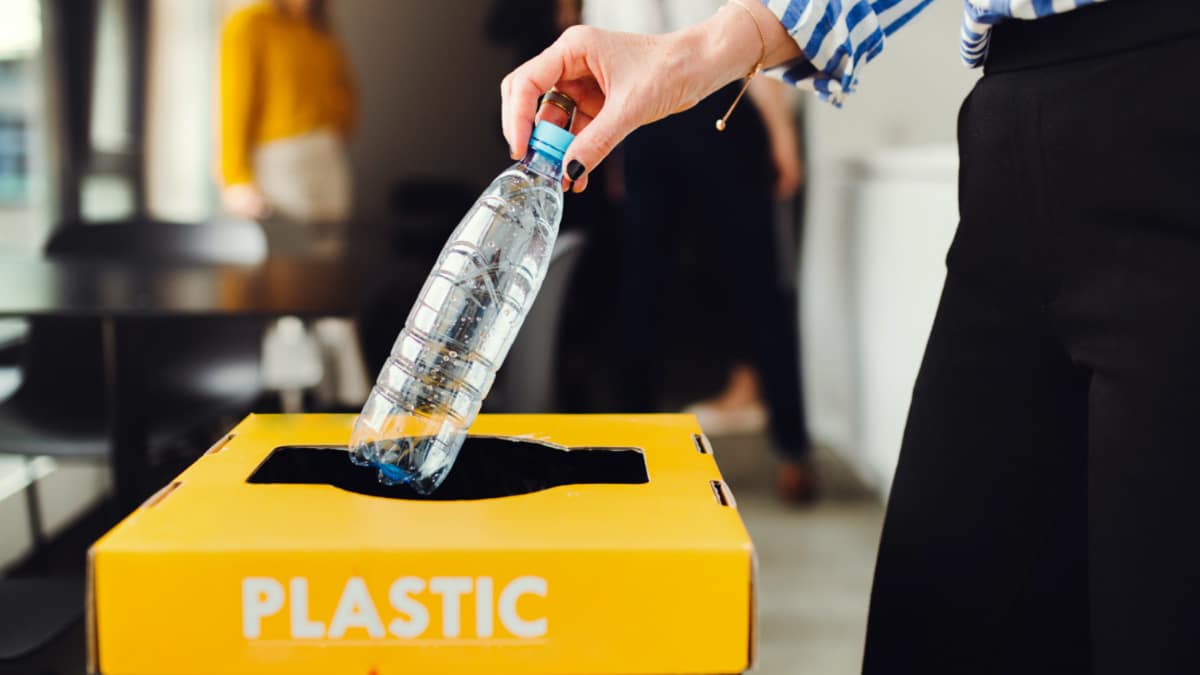

What happened to all that plastic you've put in the recycling bin over the years? Halfpoint / Getty Images
By Dr. Kate Raynes-Goldie
Of all the plastic we’ve ever produced, only 9% has been recycled. So what happened to all that plastic you’ve put in the recycling bin over the years?
Hands up if you grew up thinking that recycling plastic waste is key to saving the environment.
It turns out that for decades the recyclability of plastics was grossly oversold by the plastics industry.
The creation of this recycling “myth” is why, despite 30 years of being diligent recyclers, we have things like the Great Pacific Garbage Patch.
In fact, we’ve only recycled 9% of all the plastics we’ve ever produced. And, our use of plastics is still increasing every year.
The reality of the situation is that recycling plastics is actually really hard and expensive.
Triangle of Mistruths
The myth created around plastic recycling has been one of simplicity. We look for the familiar triangle arrows, then pop the waste in the recycling bin so it can be reused.
But the true purpose of those triangles has been misunderstood by the general public ever since their invention in the 1980s.
These triangles were actually created by the plastics industry and, according to a report provided to them in July 1993, were creating “unrealistic expectations” about what could be recycled. But they decided to keep using the codes.
Which is why many people still believe that these triangular symbols (also known as a resin identifier code or RIC) means something is recyclable.
But according to the American Society for Testing and Materials International (ASTM) – which controls the RIC system – the numbered triangles “are not recycle codes.” In fact, they weren’t created for the general public at all. They were made for the post-consumer plastic industry.
In other words, the symbols make it easier to sort the different types of plastics, some of which cannot be recycled – depending on the recycling facility.
“Unfortunately, just placing your plastic into the recycling bin doesn’t mean it will get recycled,” says Lara Camilla Pinho. She is an architect and lecturer at the UWA School of Design who is researching novel uses of plastic waste.
“The recycling system is complicated and often dictated by market demand. Not all plastic is recyclable. We cannot recycle plastic bags or straws for example.”
Behind the Scenes
So, what makes recycling plastics so difficult?
“Essentially, there are two types of plastics – thermoplastics and thermosets. While thermoplastics can be re-melted and re-molded, thermosets contain cross-linked polymers that cannot be separated meaning they cannot be recycled,” says Lara.
“Even thermoplastics have a limit to the amount of times we can recycle them, as each time they are recycled they downgrade in quality.”
Even when plastics are recyclable, it is often more costly than simply making new plastics.
Sugar, Seaweed and Mushrooms
If the conventional recycling system isn’t working, what else can we do with all the plastic we’ve created?
Lara is looking for ways to add value to recycled plastics such as using it in the design and development of architectural products. She hopes to use these architectural products to help underserved communities that are disproportionately affected by plastic waste.
In addition to recycling, we also need to find ways to reduce our use of virgin petroleum-based plastics.
Bioplastic is one such product that has been getting a lot of hype over the last few years. And although they’re better than petroleum-based plastics, bioplastics also come with their own set of challenges.
“There are already a lot of bio-based alternatives to plastic, such as bagasse – a byproduct of sugar cane processing,” says Lara.
Mycelium, a type of fungi we most often associate with mushrooms, are also providing an interesting plastic alternative.
“In the field of architecture, mycelium is starting to be used as an alternative to plastic insulation, but also as compostable packaging and bricks,” says Lara.
“The bricks take around five days to make and are strong, durable, water resistant and compostable at the end of their use.”
Hy-Fi Tower, created by The Living, is an example of a building made from these bricks.
And finally, there’s seaweed.
“[Seaweed is] cheap and can reproduce itself quickly without fertilizers. In architecture, there is use for seaweed as an alternative to plastic insulation but also as cladding,” says Lara.
More Money, More Problems
While all these alternatives are great, the main cause of our plastic dilemma is not scientific or technological, but economic.
As long as it remains cheaper to create new plastics from fossil fuels rather than from bioplastics or from recycling, we’re going to be stuck with plastic garbage islands floating in our oceans.
The true cost to our health and our environment has yet to be included in the equation. But once it is, maybe that is when the real shift will happen.
Reposted with permission from Particle.
- The Complex and Frustrating Reality of Recycling Plastic - EcoWatch
- The Recycling Dilemma: Good Plastic, Bad plastic? - EcoWatch
- The Myth About Recycling Plastic? It Works - EcoWatch
- Biodegradable Foodware Is Now Available Nationwide

 233k
233k  41k
41k  Subscribe
Subscribe 